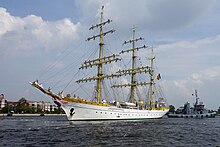Mircea (ship, 1882)
|
The Romanian brig Mircea from 1882
|
||||||||||||||||||||||
|
||||||||||||||||||||||
|
||||||||||||||||||||||
|
||||||||||||||||||||||
|
||||||||||||||||||||||
|
||||||||||||||||||||||
The Mircea was a 1882 for the Romanian Navy built sail training ship , which as a brig rigged was. In April 1944, the ship was sunk by the Soviet Air Force .
Construction and technical data
The Romanian Navy ordered the ship on November 6, 1881 from the British shipyard Thames Ironworks in Blackwall (London) . The new ship was the Navy's first training ship to provide practical training for cadets . In Blackwall the new ship was in the same year to put Kiel and ran 1882 from the pile . The hull was made of composite , the outer skin was planked with wood.
The ship was named Mircea in reference to Mircea cel Bătrân , one of the most important voivodes in Wallachia . In the 14th century, after long battles against the Turks, he had regained the Dobruja and opened up sea trade routes for Wallachia.
The Mircea was rigged as a brig with 500 m² sail area and displaced 360 tons . She was 36.00 m long, 7.60 m wide and had a draft of 3.60 m . A two-cylinder steam engine supported the sailor. It made 160 hp and worked on a screw . The ship could reach speeds of up to 8 kn under sail and up to 12 kn under steam. The armament initially consisted of two 80 mm Krupp guns, a Hotchkiss revolver cannon and a machine gun . In 1888 these were replaced by two 57 mm Nordenfelt rapid fire guns, 2 × 37 mm Hotchkiss rapid fire guns and two 11.43 mm Nordenfelt machine guns.
history
In the summer of 1882 the shipyard handed the Mircea in London over to the Romanian Navy. The ship left Great Britain in mid-July and reached Galați in Romania on August 13, 1882. Immediately afterwards, the ship's first training voyage began. In total, the ship made 17 voyages in the Black Sea , 12 in the Mediterranean and two voyages to the Atlantic during its active time . In 1890 the ship was assigned to the newly established first division, which consisted of the protected cruiser Elisabeta , the three torpedo boats of the Sborul class ( Naluca , Smeul and Sborul ) and the Mircea .
The ship attracted attention during joint trips with the Elisabeta , which the Romanian Navy also mainly used as a training ship: in 1892 the two ships took part in the celebrations for the 400th anniversary of the discovery of America in Genoa , and in 1895 they represented Romania at the opening of the Nord Baltic Canal . For the Mircea this was also the first trip into the Atlantic. In the 146-day training voyage, 18 foreign ports were visited. In the years before the turn of the century, the Mircea was also used for surveying tasks on the Romanian coast.
During the First World War , the ship was moved up the Danube. There she transported supplies to the front together with other ships. Towards the end of the war the Mircea was brought to Chilia and launched .
After the end of the war, the ship was first brought to Galați for repairs in the shipyard and at the same time rejuvenated. In 1925 the first training trip after the war followed, which led to the Mediterranean, followed a year later by a second long trip to the Mediterranean. In the years that followed, up to 1930, the Mircea stayed in the Black Sea and, in addition to training trips, also carried out surveying activities again - this time in the Danube Delta at the mouth of the Sulina arm . In May 1931 the ship was removed from the list of active ships. It is unclear whether it continued to be used as a stationary device or was launched until its successor was put into service.
At the beginning of the Second World War, the Mircea was first brought to Galați and served as a floating pharmacy, later in the same function in Brăila on the Danube. Here she was hit by a bomb during a Soviet air raid on April 12, 1944, which burned the ship.
See also
For reasons of age, the Mircea was replaced in 1939 by a new sailing training ship of the Gorch-Fock class . Based on their first sailing training ship, the Romanian Navy also named the new sailor Mircea .
literature
- Ion Rîşnoveanu: Bricul "Mircea", un nume-simbol al marinei militare române (Romanian); Journal article, place and year of publication unknown, online version as PDF .
- Navigând prin Istoria Navigând prin Istoria Forţelor Navale Române [A journey through the history of the Romanian Navy] , In: Marina Românâ. Revista Forţelor Navale Române (Romanian), edition 5/2010, ISSN 1222-9423, pp. 16–39, online version as PDF
- Valentin Ciorbea: Istoricul Navelor, Scoala "Mircea" Vol. I: Bricul "Mircea" (Romanian), Editura Academiei Navale "Mircea cel Bătrân", Constanţa 1997, ISBN 973-97913-2-8 .
- Nicolae Koslinski, Raymond Stanescu: Marina Română în Al Doilea Razboi Mondial: 1939–1945 (Romanian), Editura Făt-Frumos, Bucharest 1997, ISBN 973-552-033-8 .
Web links
- Side view of the first Mircea from 1882 at rumaniamilitary.ro, accessed on September 9, 2018
- Photo of the Mircea at historia.ro, accessed on September 9, 2018
- Brigg Mircea : Photo, technical data, short story at agenziabozzo.it, accessed on September 9, 2018
Footnotes
- ↑ Rîşnovean, p 325
- ↑ Photo of the Mircea at historia.ro
- ↑ a b Brigg Mircea : photo, technical data, short story , agenziabozzo.it
- ↑ Rîşnoveanu, pp. 325f.
- ↑ a b Marina Românâ , p. 17
- ^ Royal Roumanian Navy Cruiser Elisabeta in World War I - The war at Sea
- ↑ Rîşnoveanu, p 326
- ↑ Marina Românâ, p. 21f.
- ↑ Rîşnoveanu, p. 326ff.
- ↑ Rîşnoveanu, p 328


